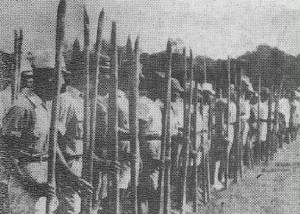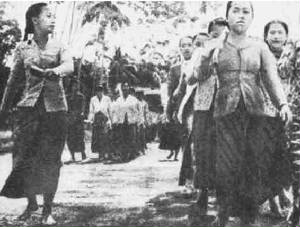|

|
| 'Seinendan' members with theirs sharp bamboos in parade. |
On April 29, 1943, coincidentally with ‘Tenscho Setsu’ (the Emperor Birthday), ‘Gunseikan’ in Jakarta
gave an order to form a total defense system from big cities to remote places by including military discipline within it.
Thus, they start to organized Indonesian settlement like in Japan. According the rule, a settlement that consisted of 10 to
15 families must be organized into a ‘Tonari Gumi’ (block organization). ‘Tonari Gumi’ leader was
chosen by its member and called as ‘Kumicho’. Five or six ‘Tonari Gumis’ were joined into a ‘Chokai’
(orchard organization). The ‘chokai’ was lead by a ‘Chokaicho’, whom chose by ‘kumichos’.
In every ‘chokai’, Japanese formed ‘Keibodan’ (security column or police auxiliary) consisted from
local youths between 20-25 years (later become 26-35 years). ‘Keibodan’ got a ‘kyoren’ training, like
how to handle fire, to face an air attack, etc. To handle theirs job, ‘Keibodan’ members have an obligation to
stand by in guardhouses in their ‘Chokai’ area and made a night watching. Theirs weapons are ‘takeyari’
(sharp bamboos). In Java, there were one million ‘Keibodan’ members.In Sumatra, ‘Keibodan’ was known
as ‘Bogadan’ while in Borneo known as ‘Borneo Konen Hokokudan’. The formation itself had been under
a tight control by Japanese to avoid Indonesian nationalist influences among theirs rank.
Japanese also tried to seed militaristic spirit among Indonesian teenagers. Thus, Indonesian teenagers between 14 to 20 years
were formed into ‘Seinendan’ (Youth Column). According Japan propaganda, ‘Seinendan’ was a tool to
educate and to train Indonesian youths, thus would enable them to defend their homeland by theirs own strength. The ‘Seinendan’
had been control by ‘Gunseikan’ himself as theirs ‘dancho’ (commander). There were ‘Seinendan’
formations in every level area. Japanese also formed ‘Seinendan’ in factories (called as ‘Seinendan Kojo’)
and farms (called as ‘Seinendan Jogyojo’).
To handle the ‘Keibodan’, ‘Gunseikan’ got help from ‘Somubucho’ and ‘Naixeibucho’
(Japanese officials in ‘Gunseikanbu’) who appointed as ’fuku dancho’ (the commander second-in-chief).
Every local official were appointed as ‘Seinendan’ leader in his area. the ‘Gunseikan’ appointed Japanese
local commanders, the local police chief in the area, and the local junior and senior high school headmasters to help him
as ‘komon’ (advisor), ‘sanyo’ (advisor council) or ‘kanji’ (administrator).
In every residency, Japanese formed ‘Seinen Kurensho’ (‘Seinendan’ Training Ground). In Jakarta, there
was a ‘Chuo Seinen Kurensho’ (‘Seinendan Training Centre’) to train ‘Seinendan’ regional
leaders for three to six months. There were almost a half million ‘Seinendan’ members in Java during the war.
Japanese also formed a paramilitary formations in junior and senior high schools called ‘Gokkutotai’ (Student
Column). They were train in basic military education, included how to fight. Every high schools became a ‘chutai’
(company) headquarter; every class became a ‘shotai’ (section). Some ‘shotais’ were joined to form
a ‘butai’ (squad). Japanese military leaders hope that ‘Gokkutotai’ will become seed for ‘heiho’,
‘kaigun’ (Japanese Navy) or ‘jibakutai’ (suicide troops).

|
| 'Fujinkai' in defile. |
Indonesian girls and women also didn’t escape from Japanese military mobilization. In August 1943, Japanese formed ‘Fujinkai’
(Women Column). The organization members were girls and women above 15 years. They got military basic training, but their
main training were to handle general kitchen and first-aid. They also were mobilized for ‘kinrohoshi’ (labor voluntary
service) because many of theirs men were use for military service. Existed in every villages, ‘Fujinkai’ were
ordered by Japanese to help them to collected obliged donation like jewelry, livestocks, foodstuffs, etc. for theirs war efforts.
By forming these paramilitary units, every Indonesian between 14 to 35 years were train to become militants to help Japanese
war efforts against possibility Allied landing in Indonesia.
|



